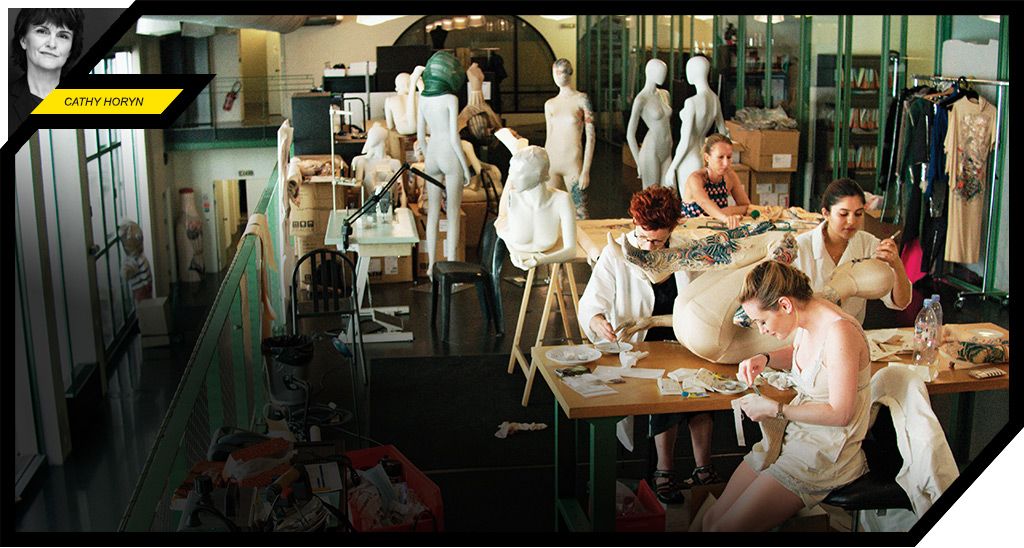Balenciaga
See it »
Elite sewing circles, where the tricks of the couture trade are being passed from one generation to the next.

The phrase she used was bon tombé du vêtement, referring to how a garment falls on the body. Jacqueline Smeyers Picot, the chief of Jean Paul Gaultier’s atelier, was saying that it’s the most important thing she has learned in 40 years of dressmaking. The effect in a dress is lyrical.
For me, the real drama of couture is not on the runway, where the collections were just shown, but inside the atelier, where nimble fingers try to conjure a field of flowers out of tiny feathers, among other acts of alchemy performed on an extremely tight schedule. Aside from the rigor of the system, the key distinction in a couture garment is that nearly everything is made by hand. Why? Because you have more control in crafting exactly what the designer wants, and also because cutting and sewing clothes by hand gives a “roundness” that contrasts with the flatness of machine-made clothes. A skirt with volume, for example, looks that way because of hand techniques. “The interfacing, the small stitches, the toile hold the fabric and the shape,” explains Monique Bailly, a head tailor at Dior and a star of the recent documentary Dior and I.
The clothes may be extravagant, but the work is unpretentious. A couture atelier is a glorified sewing circle, with older hands showing the greenhorns how it’s done, and everybody quietly gabbing as they work. Federica Papalini, who recently joined the 75 seamstresses at Valentino as an apprentice, says, “You have to be very meticulous. Details are important. But you have incredible teachers in the girls who have more experience.” Bailly’s apprentice Meghan Cossec spoke too about the continuity of “generations following each other.”
Today, young people like Papalini see couture as an opportunity rather than as a dead end — a huge difference from 20 years ago. Pierpaolo Piccioli of Valentino says, “There’s a new dignity to it. Young people see the art of couture.” The house of Valentino will soon open a dressmaking school in Rome, taught by some of the premières, including Antonietta De Angelis and Elide Morelli — with the house for 30 and 48 years, respectively. The nine-month program will have room for ten students.
Not long ago, I asked Karl Lagerfeld what makes something “couture,” and for once he was stumped: “It’s difficult to say.” Maybe couture is the idea of something being produced only once, a sense of its ephemerality. But it is the opposite, too. As Bailly points out: “Handmade gives longevity to a garment. The garment, so to speak, is eternal.”
*A version of this article appears in the July 13, 2015 issue of New York Magazine.
BEGIN SLIDESHOWTo be fair, it was a 13 foot-long dress.
You and Rihanna Will Both Want to Invest in Dior’s New BagIt's got something for everyone.
Polo Shirts Have Turned Their Back on Ryan LochteAlong with his other major sponsors.
Ryan Lochte Will No Longer Be Paid to Wear Tiny Bathing SuitsSpeedo remains committed to transparency.
Laura Brown Is the New Editor-in-Chief of InStyleAfter 11 years at Harper’s Bazaar.
Tyra Banks Is Going to Teach a Class on Smizing at Stanford"If I see somebody not paying attention, I’m gonna call on them."
This Floating Pier Is the Most Zen Installation EverWalking on water in Italy.
Nation Is Appalled by Matt Lauer’s Nude Ankles During Ryan Lochte InterviewWhat’s the opposite of “Jeah”?
8 People at the Life of Pablo Pop-up Explain Why Kanye West Is a God"I mean, Kanye West is just Kanye West. There's not more or less you can say about Kanye West. He's just Mr. West!"
A T-shirt Is EnoughSimplicity, versatility, and cool. What more could you want?
She took a perfect pencil dive off a 30-foot yacht.
American Apparel Is Being Sued by Former WorkersAs the company considers putting itself up for sale.
A Gendered History of the Tailored SuitFrom Marlon Brando to Coco Chanel.
How Zendaya Developed Such Great Style at the Young Age of 19The star's best looks from Disney to now.
Proof That If You’re Chic Enough, a Little Federal Investigation Doesn’t MatterIs this the best they could do?
5,300-Year-Old Mummified Iceman Probably Would’ve Been a Street-Style StarHe had several different looks and was “pretty picky.”
J.Crew Has Identified 226 Shades of PinkEven more than there are shades of gray.
Gigi and Bella Hadid Merch Is Now Somehow a Thing That Is HappeningToday in Hadidiana.
Gird Your Loins for the Return of Yeezy to New York Fashion WeekThe season approaches.
This Indie Brand Had a Great Response to Ivanka TrumpWhen she bought one of their cuffs, they donated the proceeds to the Clinton campaign.